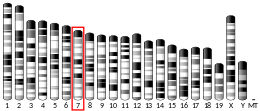| KCTD13 |
|---|
|
| Available structures |
|---|
| PDB | Ortholog search: PDBe RCSB |
|---|
|
|
| Identifiers |
|---|
| Aliases | KCTD13, BACURD1, PDIP1, POLDIP1, hBACURD1, FKSG86, potassium channel tetramerization domain containing 13 |
|---|
| External IDs | OMIM: 608947; MGI: 1923739; HomoloGene: 27800; GeneCards: KCTD13; OMA:KCTD13 - orthologs |
|---|
| Gene location (Human) |
|---|
 | | Chr. | Chromosome 16 (human)[1] |
|---|
| | Band | 16p11.2 | Start | 29,905,012 bp[1] |
|---|
| End | 29,926,236 bp[1] |
|---|
|
| Gene location (Mouse) |
|---|
 | | Chr. | Chromosome 7 (mouse)[2] |
|---|
| | Band | 7|7 F3 | Start | 126,528,051 bp[2] |
|---|
| End | 126,544,803 bp[2] |
|---|
|
| RNA expression pattern |
|---|
| Bgee | | Human | Mouse (ortholog) |
|---|
| Top expressed in | - right testis
- left testis
- nucleus accumbens
- anterior cingulate cortex
- right frontal lobe
- prefrontal cortex
- amygdala
- Region I of hippocampus proper
- caudate nucleus
- right hemisphere of cerebellum
|
| | Top expressed in | - primary visual cortex
- superior frontal gyrus
- subiculum
- zygote
- dentate gyrus
- dentate gyrus of hippocampal formation granule cell
- piriform cortex
- globus pallidus
- cingulate gyrus
- hippocampus proper
|
| | More reference expression data |
|
|---|
| BioGPS | 
 | | More reference expression data |
|
|---|
|
| Gene ontology |
|---|
| Molecular function | - ubiquitin-protein transferase activity
- protein binding
- identical protein binding
- protein domain specific binding
| | Cellular component | - Cul3-RING ubiquitin ligase complex
- nucleus
- nuclear body
| | Biological process | - positive regulation of DNA replication
- DNA replication
- protein homooligomerization
- cell migration
- protein ubiquitination
- stress fiber assembly
- proteasome-mediated ubiquitin-dependent protein catabolic process
- negative regulation of Rho protein signal transduction
- positive regulation of synaptic transmission
- neural precursor cell proliferation
| | Sources:Amigo / QuickGO |
|
|
| Wikidata |
| View/Edit Human | View/Edit Mouse |
|



















